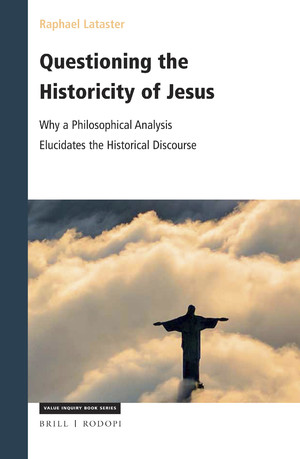I discuss here my reading of Chapter 5 of Raphael Lataster’s Questioning the Historicity of Jesus. Here he looks at the problematic nature of the gospels and extra-biblical sources for Jesus.
Lataster discusses how historical Jesus scholars attempt to get around the problem that there are no primary sources for a historical Jesus. This absence leads scholars to focus on
1) the character and limitations of presumed oral traditions that bridge the gap between the gospels and the historical Jesus;
2) memory theory, what we theorize and know about social and individual memories.
Both of these studies do indeed raise awareness of problems for a historian’s access to a historical Jesus and Lataster cites numerous scholars who have contributed to our awareness of these problems. I suggest, however, that much of the discussion is at best a footnote to a debate over whether there was a person of Jesus at the start of Christianity. After all, the problems relate to the reconstruction of such a Jesus. If Christianity had some other origin then memories or oral traditions cannot have any relation to “a historical Jesus”.
Josephus
The most famous extra-biblical reference to a historical Jesus is the Testimonium Flavianum of Josephus. Lataster’s discussion is a thorough coverage of the weaknesses of attempts to salvage even a smaller core of the surviving sentences, again citing a range of recent scholars who have expressed serious reservations about Josephus ever having said anything at all about our Jesus. I was pleased to see a detailed quotation from a publication by a distinguished professor in the field of linguistics, Paul Hopper. (Interested readers can see the quotation in an older post here.) As for the second passage in the Antiquities of Josephus, one which appears to be an after-thought reference to a Jesus related to a certain James, Lataster highlights Richard Carrier’s argument that the Jesus referred to is Jesus son of Damneus. (See David Fitzgerald Responds for details of the argument.) Carrier’s view makes some sense but I am not entirely sure it resolves all questions and for that reason I prefer Earl Doherty’s original discussion as the more satisfactory. But either way, there are significant problems with the view that Josephus identified James as “the brother of Jesus, the one called Christ”, both in syntax and context. It is important to address both Josephan passages but as Lataster notes,
it is important to realise that even if authentic, these verses do not necessarily confirm the existence of the Historical Jesus.
(Lataster, p. 200)
 Josephus is writing decades after the supposed historical Jesus and adds nothing to what is known from other sources, the implication being that there is no reason to suspect that either passage had any source other than Christians, either as Josephus’s late first century source or as later copyists of his work.
Josephus is writing decades after the supposed historical Jesus and adds nothing to what is known from other sources, the implication being that there is no reason to suspect that either passage had any source other than Christians, either as Josephus’s late first century source or as later copyists of his work.
Other sources
Lataster’s comprehensive discussions of other ancient sources mentioning or interpreted as alluding to either Jesus or Christ — Tacitus, Pliny, Thallus, Suetonius, Mara bar Serapion, and the Talmud — draw in both scholarly rebuttals and common answers that as far as I am aware have never been countered by anyone attempting to use them as evidence for a historical Jesus. A new point concerning Pliny’s letter about Christians to emperor Trajan is also covered: Enrico Tuccinardi has applied a stylometric analysis that strongly indicates the entire passage is a forgery.
Scholarly “confessions”
As for the canonical gospels, Lataster reminds us of the major obstacles to accepting them as sources for a historical Jesus. They are late documents, at least forty years after the narrated crucifixion, and they are accepted by critical biblical scholars as mythical or theological narratives of Christ, not a historical person. Whatever the form of Jesus behind them — historical or mythical — they are nonhistorical elaborations that have come to hide whatever that original concept was. Lataster buttresses his point with citations from critical biblical scholars. One such noteworthy name is that of the pioneer of the Jesus Seminar, Robert Funk:
As an historian, I do not know for certain that Jesus really existed, that he is anything more than the figment of some overactive imaginations… In my view, there is nothing about Jesus of Nazareth that we can know beyond any possible doubt. In the mortal life we have there are only prob abilities. And the Jesus that scholars have isolated in the ancient gospels, gospels that are bloated with the will to believe, may turn out to be only another image that merely reflects our deepest longings.
(Robert Walter Funk, “Bookshelf: The Resurrection of Jesus,” The Fourth R 8, no. 1 (1995): 9., in Lataster, p. 219)
Given the prevailing near consensus that the Gospel of Mark is the earliest gospel it is reasonable to consider the possibility that all subsequent references to and portrayals of a historical Jesus can go back to that gospel. Lataster cites Bart Ehrman to this effect:
If there had been one source of Christian antiquity that mentioned a historical Jesus (e.g., Mark) and everyone else was based on what that source had to say, then possibly you could argue that this person made Jesus up and everyone else simply took the ball and ran with it.
(Lataster, p. 220, citing Erhman from https://ehrmanblog.org/gospel-evidence-that-jesus-existed, accessed 05/04/2017.)
